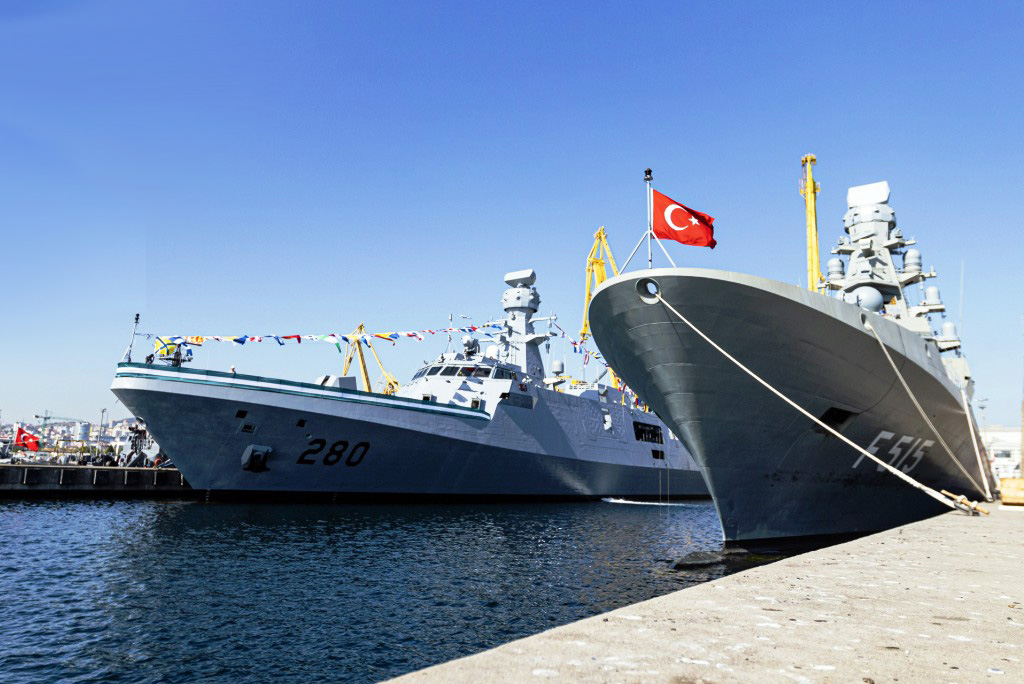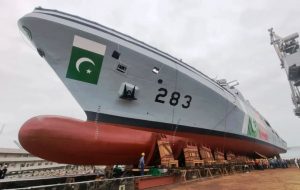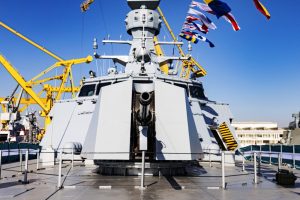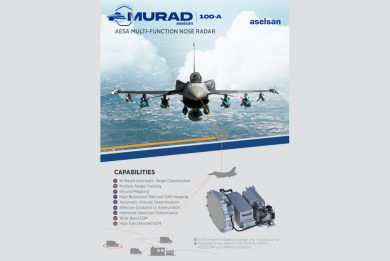
ASFAT masterpiece: the Babur-class Pakistan Navy MILGEM corvette programme
On 23 September 2023, the Pakistan Navy took delivery of the first of four Babur-class corvette from ASFAT, the Turkish Ministry of Defence’s wholly owned subsidiary supporting military factories/shipyards and national industry in export programmes. The ceremony was attended by Turkish Defence Minister Yasar Güler and his Pakistani counterpart Anwar Ali Hayder at Istanbul Naval Shipyard
This event represented a major significant delivery milestone in the Pakistan Navy MILGEM project. This contract was signed in September 2018, only eight months after the establishment of ASFAT in January 2018. It was the highest figure ever signed by the Turkish defence industry related to naval projects.
It regards not only the design, shipbuilding, outfitting and delivery of four corvettes to Pakistan Navy but also their concurrent construction – two ships each – in both Istanbul Naval Shipyard and Karachi Shipyard & Engineering Works (KSEW) in Pakistan, in the latter case through the transfer of technology agreement and local support, alongside the familiarization of the Pakistan Navy’s crews by the Turkish Navy and industry.
It represented a major effort by Turkish Ministry of Defence and Navy, and the national industry, all orchestrated by ASFAT, which manages the whole programme through its offices and sites in Türkiye and Pakistan.

The shipbuilding programme became effective in March 2019, the steel cutting ceremony of the first-of-class corvette was held in January 2020 at Istanbul Naval Shipyard, and the launch was celebrated in August 2021. “After the first-of-class Babur (280), the launch of Badr (281) followed at KSEW shipyard in Pakistan in May 2022, the third ship Khaibar (282) in November 2022 at Istanbul Naval Shipyard and the last-named Tariq (283) in August 2023 at KSEW. The second and third ships of the class are planned to be delivered in 2024 while the fourth will follow in 2025. Despite the worldwide negative effects of the pandemic, all phases and milestones are on schedule without any delay,” Sinan Topuz, director of business development at ASFAT said. Both the Babur and the Khaibar corvettes were present during the international media tour at the Istanbul Naval Shipyard in different stage of completion. The final familiarization and operational training activities of Babur are being performed with Turkish Navy assistance and the ship is expected to leave the shipyard in early 2024.

Babur-class corvettes
Based on the MILGEM Ada-class corvette design for the Turkish Naval Forces Command, Babur-class platforms for the Pakistan Navy differ mainly for the combat suite equipment. With a full load displacement of 2,985 tonnes, a length and beam of respectively 108.2 and 14.8 meters and a draft of 4.1 meter, the Pakistan corvettes have the same CODAG-configured propulsion system on two shafts with controllable pitch propellers, centred on a General Electric LM-2500 gas turbine and two MTU 16V595TE90 diesel engines providing a maximum speed of 26+ knots and a range of 4,000 nm at 14 knots. Electrical power is provided by four 560 kW-each diesel generators. With accommodations for 142 personnel, the new corvette has a stern flight deck and hangar capable to handle a 10 tonnes helicopter, together with an unmanned air vehicle. The Pakistan Navy is expected to embark the in-service smaller Z-9EC. The Babur-class corvettes have a stern ramp and a port side boat bay for 5.5 and 7.5 meters long RHIBs.
The Babur-class maintains the same Havelsan Advent command management system and ship data distribution of the Turkish ships while the sensors suite includes the Aselsan SMART Mk2 3D surveillance and tracking radar, the Aselsan ARES 2N RESM in a customized export version with a different antenna layout, and two STO2SE infrared search and tracking (IRST) systems, which were under canvas during the media visit to the Istanbul Naval Shipyard. The navigation suite includes two Aselsan VionMaster FT HSC radars and one Aselsan surface search Alper LPI NG SP radar. The underwater self-protection suite includes a Meteksan Yakamos 2000 hull-mounted sonar and an Aselsan anti-torpedo Hizir package with towed array and decoy launchers, while two Aselsan decoy launchers support defence against missiles, air and surface threats.

A Thales STIR 1.2 EO Mk 2 fire control system manages the Leonardo 76/62 mm Super Rapido main gun which is part of a potent armament suite together with the Aselsan Gökdeniz 35 mm twin gun mount with dedicated fire control sensors, capable to fire Aselsan ATOM air burst ammunitions. The Pakistan Navy is the launch customer for the MBDA Albatros NG, the Babur-class corvettes being the first platforms to be equipped with that air defence system; it is based on the CAMM ER missile, hosted in two 3×2 vertical launching systems, and according to MBDA official documentation it provides a range coverage in excess of 40 km. Two Aselsan STOP 25 mm remotely controlled guns offer defence against surface and air threats, while two Leonardo B515 triple launchers for lightweight torpedoes deal with underwater threats. Although no information has been provided on the anti-ship/land strike capability, according to the images and previously disclosed information by other sources, the Babur-class corvette can be equipped with the Pakistani Global Industrial & Defence Solutions (GIDS) Harbah subsonic anti-ship and land attack cruise missile, with a range of over 280 km, to be fired by two triple launchers.
Pakistan Jinnah-class frigate: the first indigenous and national frigate with ASFAT support
The company representative stressed the ASFAT’s determination to continue supporting and expanding the business relations with Pakistan, assisting “our ally and friendly country” in the Jinnah-class frigate programme.
As part of the technology transfer agreement with Pakistan related to the PN MILGEM project, the ASFAT Design Office is cooperating with the Pakistan Navy’s Platform Design Wing in the design of the Jinnah-class frigate (JCF) project to meet the operational requirements of the service, intellectual proprietary rights being equally shared.
Designed and constructed entirely in Pakistan at Karachi Shipyard and Engineering Works (KS&EW), according to the ASFAT representative the project also includes a technology transfer program. For the first time Türkiye is transferring to a foreign country the design know-how of a main combatant warship.
“We hope that a significant proportion of systems and parts from Turkish companies will be used in the Jinnah-class frigates, as was the case for the Pakistan Navy MILGEM project,” he said. With a displacement of more than 3,000 tonnes, a length and beam respectively close to 119 and 15 meters, together with a draft of 4.0 meters, the Jinnah-class frigate was designed and will be equipped with systems, sensors and weapons to conduct multi-threat operations alongside with SAR duties.
Photos courtesy Turkish MoD, ASFAT and L. Peruzzi


